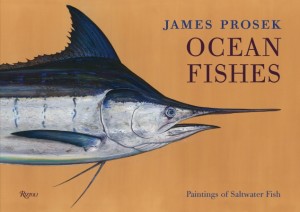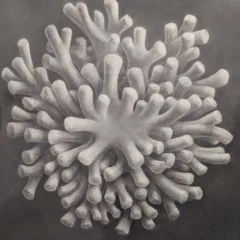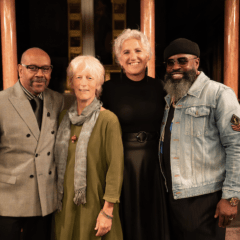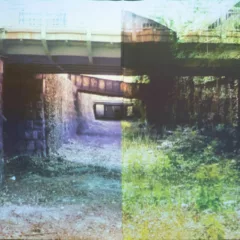Tom Uttech’s works are a kind of mystical realism. The woods, animals, birds, rocks and clouds in his oil paintings (recently closed at Swarthmore College’s List Gallery) look like the real thing, however, nature in Uttech’s works has been transported to some extraordinary realm, where birds don’t act bird-like and clouds and bears are not really like themselves either.
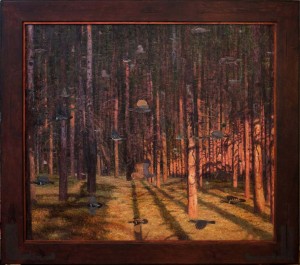
Take the bear/man hybrid (a stand-in for the artist and viewer) that appears in many of Uttech’s works, for example. It looks out on the landscape, its back to you, a mysterious presence in a wondrous land. Sometimes the bear’s shape is echoed in the cloudscape above, as if in salute.
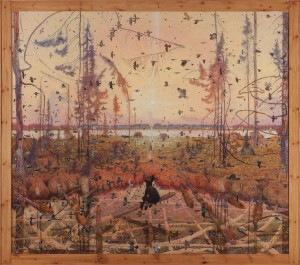
Often times in these paintings, birds of all species flock together, flying through the trees, most going the same direction, a parade of bird species like Audubon could have painted if he was a mystic inclined to painting scenes and not documentary illustrations.
Uttech, who lives in Wisconsin and for many years taught art at the University of Wisconsin, Madison, spends time with nature — he’s an avid hiker. He is painting what he knows, but also what he imagines, hopes or fears. These are not documentary works, although they do chronicle places the artist has visited like sacred Native American grounds where ancient petroglyphs populate the rocks.
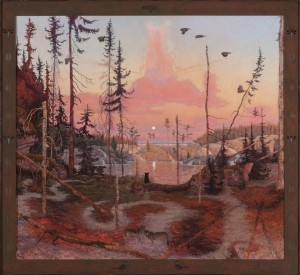
The Romantic movement and Caspar David Friedrich come to mind when looking at Uttech’s works. Just as Friedrich shows hikers and nature wanderers in his sublime and mournful landscapes, Uttech’s poses his lonely bear, looking wholly enraptured by the sublime around him. The world in this exhibit, titled Adisokewinini (the Ojibwe word for “tale-teller”), is one of wonderment, but also questioning. That bear/man is on a journey of exploration that has no pat answers.
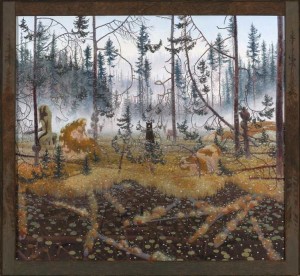
Friedrich and Uttech almost bump up against kitsch in their depictions of the natural sublime. But the level of self-conscious questioning in their paintings makes them stand apart. There is the mystery of death and discomfort in these works. In a search for meaning they use beauty as a tool, but Uttech, in so very many ways, is not Thomas Kinkade. Uttech is not selling a land of comfort and honey-coated truths.
In Mamakadjidgan (2011-2012), perhaps the most riveting work in the show, and also the largest at 91×103,” there is devastation suggested. The bear/man sits perched on a denuded tree branch in a limbo-like undefined space. The marvelous pinky-orange piece, in which birds of all species, including some extinct, fly in a gridded pattern, suggests order. But it is order subverted — no birds fly this way, ever. And no space like this really exists.
PAFA Curator of Modern Art Robert Cozzolino, in the catalog for the show, talks about the American Transcendentalists and naturalist Aldo Leopold and their relationship to Uttech’s mystical naturalism. I love putting Uttech in that transcendental zone — it’s where he belongs.
Like Uttech, artist James Prosek is a chronicler of nature, but more than that, a lover of nature whose works call to mind the life and death struggles that are part and parcel of being alive and in the natural order of the food chain.
Prosek’s subject is fish, and he is most famously known for his 2003 book, Trout: An Illustrated History. His new book Ocean Fishes: Paintings of Saltwater Fish is a gorgeous book with full-page spreads (and pages and pages of details) of the artist’s portraits of sea bass, marlins, yellowfin and bluefin tuna and more. But in addition to the lovely, really intense depictions of fish (treated as if they were known individuals and, now dead and sorely missed) the book is also a great read.
Essays by Peter Matthiessen, Robert M. Peck and Christopher Riopelle give context to the subject of fish as living things that bring joy to fishers (Matthiessen); fish as needed specimens for scientists (Peck) and fish as art historical subjects through the ages (Riopelle).
Mattheissen’s autobiographical stories of being on the water, on boats, there for the hunt and capture of the fish, are imbued with enough salt spray you can feel it. Peck’s lyrical musings on Audubon and Prosek, and other artists who painted nature from dead specimens, helped me understand that these paintings are not documentary only, but statements of beauty and the transitory nature of life. Peck’s story of a Hemingway connection to the Academy of Natural Sciences is also a terrific yarn. And Riopelle, who puts Prosek into the Realist tradition of Courbet, Manet and Eakins, contextualizes the works as monuments to nature, made by an artist with his eyes open who has exquisite empathy for the being he has stalked, and watched get caught and die in front of him. From Riopelle I learned that Prosek paints a little self-portrait into the eye of his fish. And from Prosek’s own essay I learned that the artist relives the entire life-to-death experience over again in his mind’s eye, while he is painting the work.
What Uttech and Prosek ask you to do is to open your eyes to the beauty of the world, and then think of how ephemeral that beauty is, and how death is always there amidst the beauty. At a time, in winter, when most of us will be indoors and few of us will be out with nature, spending some time with Uttech and Prosek is good for the soul.
Tom Uttech: Adisokewinini, Swarthmore College, List Gallery (just closed). See a nice video of a gallery walk-through with commentary by Gallery Director Andrea Packard. If you missed it, catch the exhibition on view at Uttech’s New York gallery, Alexandre Gallery, February 21–March 30, 2013.
Ocean Fishes: Paintings of Saltwater Fish, by James Prosek.
Rizzoli New York
ISBN: 978-0-8478-3907-0 $39.95 US/
hardcover, 184 pages, 10×7″, 60 color illustrations


